Learning In the Shadow of Coal
Air Date: Week of May 25, 2007
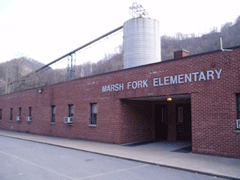
Learning in the shadow of coal. A Massey energy company coal silo looms over Marsh Fork Elementary. The company wants to build a second silo even closer to the school. (Photo: Jeff Young)
For our series “Generating Controversy: the Changing Climate of Coal,” Living on Earth's Jeff Young visits a West Virginia community where schoolchildren get their lessons in the shadow of a coal mine - literally. Some residents say the massive mountaintop removal coal mine and its lagoon of liquid waste threaten the school's safety and they're determined to get either the school or the mine moved.
Transcript
CURWOOD: Back in February of 1972, more than 100 million gallons of toxic liquid waste from coal mining operations broke through a dam in West Virginia’s Logan County and rushed down Buffalo Creek.
SURVIVOR: I took off running and warned the people down the creek as I went that the water was coming. They wouldn’t believe me and I told em’ I said well look there you can see the house coming down the creek, but still they didn’t believe me. There was many lives lost, this is the most tragic thing I’ve ever seen in my life. I’m sorry that God let me live to see it.
CURWOOD: The black water tore through the Buffalo Creek ravine killing 127 people injuring more than a thousand and destroying more than five hundred homes. Out of the Buffalo Creek disaster came improved standards and oversight of what are known as coal “slurry impoundments.” But safety and environmental concerns persist to this day. There are still roughly 150 of these toxic lagoons in the region, many of them associated with what are known as mountaintop removal coal mines. Folks in the tiny West Virginia community of Marsh Fork are especially concerned about a massive coal slurry impoundment: If the dam should break it would almost instantly flood the local elementary school. Living on Earth’s Jeff Young traveled to Marsh Fork for the latest story in our series, Generating Controversy: the Changing Climate of Coal.
[FEET TRAMPING, BREATHING SOUNDS]
YOUNG: For a grandpa, Ed Wiley can cover a lot of ground. I can barely keep his wiry frame and camouflage cap in view as we hoof up a ridge near his home. He has mercy and stops for a swig of water.
WILEY: I’m winded, too.
YOUNG: You’re just saying that to make me feel good.
[BIRD SONG]
YOUNG: A thrush and cardinal sing in the oak and hickories; May apples and fiddlehead curls of fern hide our boots. Wiley walks these woods a lot, looking for bear or turkey, mushrooms or ginseng, or sometimes, just peace of mind.
WILEY: I feel protected here and it don’t happen every time, usually when I’m alone, but you get the presence of the Lord, you know, touchin’ down on you. And I don’t get it nowhere’s else.
YOUNG: He won’t find the Lord or bear or anything else here much longer.
[WIND BLOWING IN THE TREES]
YOUNG: This mountaintop and everything on it is being removed in the search for coal.
WILEY: They’re just leveling our mountains in here just literally leveling them with the type of mining they’re doing.
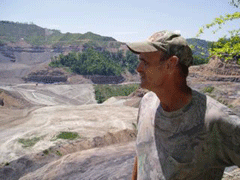
"Like maggots eating our mountainsides." Ed Wiley looks over the mountaintop removal mine just above Marsh Fork Elementary. The ridgeline in the distance will soon be leveled by explosives and the rock and dirt dumped in the valley below.(Photo: Jeff Young)
YOUNG: We crest the ridge, the wind picks up and the land simply falls away. A crumbling, man-made cliff called a highwall drops to a rock and dirt pit hundreds of yards across. On the far side another cut reveals seams of coal between layers of rock. The top of that hill is scalped of trees.
WILEY: I would say by the middle of summer that mountain there will be gone. It’ll all be gone. The ridge that you’re walking on is gonna be gone, too.
YOUNG: And down below all this is where your granddaughter went to school?
WILEY: Right. Yeah, just it’s less than a half-mile from where we’re standing here.
YOUNG: Wiley’s granddaughter Kayla was a student at Marsh Fork Elementary, just beside this mine’s coal preparation plant. Just beyond that is a 350-foot tall dam built from the rock and earth remains of these hills. The dam holds back a lagoon of semi-liquid waste left over from washing the coal.

Learning in the shadow of coal. A Massey energy company coal silo looms over Marsh Fork Elementary. The company wants to build a second silo even closer to the school. Some parents think the mine is a health and safety risk. School principal Louise Maynard says, "we are all going to die of something." (Photo: Jeff Young)
WILEY: And when you’ve got 2.8 billion gallons of toxic sludge sitting over an elementary school, it’s not good. It’s sad, it’s very very sad what’s happened here. The best way I can say it is, is it looks like to me like a bunch of maggots eating away at our mountainsides. And we have them all around us here. If you get up in an airplane the farther you look the more you’ll see.
[AIRPLANE ENGINE]
YOUNG: I take Wiley’s advice and get an aerial view thanks to Sue Lapis, a volunteer pilot with a conservation group called Southwings. We fly from Charleston, the state capital, over forested hills like ocean waves. When we reach mining country those hills look more like flat-topped mesas. One after another has been blown apart. Lapis points out a dragline crane higher than a ten-story building. Trucks with tires as tall as men dump rock and earth into valleys below.
LAPIS: (on head set) now all they have to do is keep blasting and keep harvesting coal until the mountain is gone. What a nasty way to get electricity!
YOUNG: Coal provides about half the country’s electricity, and Appalachia provides more than one-third of the country’s coal.
A government study found that at least 800 square miles of mountaintop have been removed and some 12 hundred miles of streams polluted or completely buried by mine waste. At this rate mountaintop removal will affect nearly one and a half million acres - an area the size of Delaware - by the end of this decade.
Lapis dips a wing to circle the mine above Marsh Fork. The school looks like a tiny box; the waste lagoon a bruise on the raw earth.
LAPIS: My view as a pilot is to look up into this amazing destruction that’s above the school and there’s a gigantic slurry dam impoundment right there; an amazing juxtaposition of children and environmental catastrophe. What are they thinking?
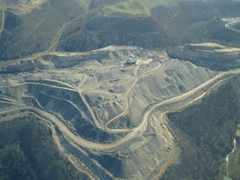
"Nasty way to get electricity," pilot Sue Lapis says as she looks down on one of the many mountaintop removal mines transforming the Appalachian landscape. The dragline crane near the top of this photo stands taller than a ten-story building. (Photo: Jeff Young)
YOUNG: Not long ago Ed Wiley didn’t give much thought to any of this. He used to work on the mine with a contracting company, getting good money and - for the first time in his life - health insurance.
Then his granddaughter started getting sick at school—pale with headaches and fatigue.
[OUTDOOR SOUNDS]
YOUNG: When he took her home early from school for the third time he noticed what seemed like a lot of names on the student sign-out book - a lot of kids going home sick. He buckled Kayla into the seat of his pickup.
WILEY: And she turns and looks at ya and tears are pourin’ down this little girl’s eyes. And she says, gramps these coalmines are making us kids sick. That hurt. That hurt me. You know, it took her tears to wake me up. And it was like a sledgehammer.
YOUNG: It’s still not clear what might be making school kids sick. An independent air test found coal dust in the school. But other government tests found nothing that could account for illnesses.
Wiley thinks it has to do with the blasting and dust, and the hazardous warning labels on chemicals he’d seen at the mine and its prep plant. And then there’s the dam. Wiley heard troubling stories from workers about its construction and safety violations against the company. He thought of all the rainwater that will run from the mined land adding pressure on the dam during storms. He saw it all pointing to trouble for the little school.
[SCHOOLYARD, CHILDREN PLAYING, JUMPING ROPE]
CHILDREN: Cinderella dressed in yellow went upstairs…
YOUNG: Like nearly everything else here, Marsh Fork Elementary sits on the scarce flat land between the main road and the creek, in the narrow valley carved by a branch of the Coal River. Looming above the school is the silo of the coal company’s preparation plant. Coal is washed with a chemical bath to remove impurities, and stored in the silo. Then it’s sprayed with more chemicals to keep it from freezing in winter, to keep it in place on train cars. This happens less than 300 feet from where these children play.
DYE: What can I say? I mean it’s the major source of industry. It’s the major source of jobs. Without the coal mining nothing functions around here.
YOUNG: Dennis Dye teaches physical education at Marsh Fork. Dye says air quality tests and a visit to the mine convinced him that Wiley’s safety concerns are overblown.
DYE: I guess there can never be a guarantee that a slurry impoundment won’t fail. But I’ve been up there and there will be a lot of other things in this state fail before that impoundment fails.
[SCHOOL KIDS IN HALLWAY]
YOUNG: The main fear from staff is that the controversy about the mine will end up closing the school. Principal Louise Mollohan Maynard would much rather be bragging about her students going to a state math fair than talking about safety issues with a reporter.
MAYNARD: Probably the thing that bothers me the most is the outsiders. And I think we have a lot of outside influences that are causing us a lot of problems.
YOUNG: That mine is enormous and the impoundment is enormous. In the past those things have failed. Doesn’t that bother you?
MAYNARD: I was raised in a coal mining town my father was a coal miner and you get used to some things when you live in this area just like people do who live in the, around steel plants, or whatever the circumstances are. And I pray nothing ever goes wrong, but there is no guarantee of that with anything. And we are all brought into this world and the minute we come into this world then we begin the process of going out of this world. We’re all going to die of something, whether it’s old age, natural cause, falling off our front porch, a flood. We’re all going to leave this earth someway.
YOUNG: Federal law clearly forbids coal mining within 300 feet of a school. But Randy Huffman of the West Virginia Department of Environmental Protection explains this mine and the school predate the law.
HUFFMAN: It was there before mining was regulated and when the law was passed to regulate mining it was grandfathered.
YOUNG: That was 1977. The mine then was nothing like the one today. Then it was an underground mine. And it was not owned by Massey Energy, the nation’s fourth largest coal producer.
Even in an industry where safety and environmental problems are common, Massey’s record stands out. This month the federal government sued Massey for more than four thousand violations of the Clean Water Act—possibly more than a billion and a half dollars in fines.
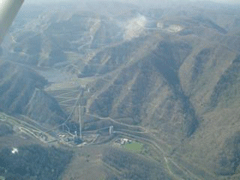
The Massey energy coal company's slurry impoundment and dam. The small white square in the lower foreground is Marsh Fork Elementary. In 2000, another Massey-owned impoundment failed, releasing tons of liquid waste. "It just does not make sense," mine safety expert Davitt McAteer says, "to put a school and impoundment in close proximity." (Photo: Jeff Young)
Yet Huffman declines to say that Massey’s impoundment at Marsh Fork warrants extra attention.
HUFFMAN: I don’t make judgments about who we should trust and who we shouldn’t. We are tasked with enforcing the law based upon certain parameters and permit requirements. I do feel that the children are safe from the impoundment breaking through. To the degree that that helps anyone feel better, I’m confident that the children are safe.
YOUNG: Huffman’s agency is trying to stop Massey from building a second coal silo at Marsh Fork, this one even closer to the school. The matter is under appeal.
Massey representatives did not respond to several interview requests for this story.
During the Clinton administration Davitt McAteer directed the federal mine safety and health administration, the country’s top coal safety watchdog. McAteer’s now a vice president for Wheeling Jesuit University, where he compiled a comprehensive database of coal impoundment safety - all the failures, slurry spills and other incidents.
MCATEER: The Massey company has a higher rate of failures, failure-slash-incidents, than any other company that operates impoundments in the country. Those are the facts.
YOUNG: McAteer says he sees no evidence of imminent danger of failure at the Marsh Fork impoundment. But he remembers the tragedy at Buffalo Creek. And he knows that dams of this nature are ten times more likely to fail than the concrete dams most people are familiar with.
MCATEER: It just isn’t logical and isn’t - I don’t think it’s very responsible to put an impoundment and a school in proximity to one another. Failures are rare but failures do exist. And so why do we put the children in harm’s way? It just makes common sense, it’s logical to take the children out of harm’s way and that makes the most sense to me.
YOUNG: That makes sense to Ed Wiley, too. He organized “pennies of promise,” a campaign to raise money to move the school to a safer place. It’s been difficult, he says.
WILEY: It’s hard to get people that’s dependent on this for work, their livelihood, to speak out. It’s a tough issue. I feel this is willfully and knowingly leaving these kids in harm’s way. This is a form of child abuse at its highest level.
YOUNG: Wiley took his concerns to West Virginia Governor Joe Manchin. Manchin ordered some health testing at the school and fought Massey’s attempt to build a second coal silo at Marsh Fork. But time dragged on with no commitment from the governor for a new school. So Wiley joined a group of demonstrators and occupied the governor’s office at the capitol.
DEMONSTRATORS: What do you want? A new school in Marsh Fork community.
YOUNG: Manchin had state troopers haul the demonstrators away.
[SOUND OF DEMONSTRATORS CHANTING. “SHAME” AS PROTESTERS ARE ARRESTED. A YOUNG WOMAN SHOUTS IN PAIN.]
YOUNG: Wiley contacted his congressman, Democrat Nick Rahall. Rahall chairs the powerful House committee on Natural Resources and is a strong supporter of coal.
RAHALL: Yes coal provides a livelihood to a vast number of people in my district and in West Virginia. Yes, coal is a friend to West Virginia.
YOUNG: Rahall helped write surface mining law thirty years ago. It allows mountaintop removal mining but requires that the reclaimed mine sites be put to good use.
RAHALL: It happens to be in some parts of our country like in southern West Virginia flat land is at a premium. And where we have mountaintop mining is done in a responsible manner. We have very good public works on top of those sites. It’s not like you’re just whacking down mountains and you’re doing it in an irresponsible fashion.
YOUNG: After years of requests to state and federal officials Ed Wiley had run out of patience. But not out of energy. He put a “pennies of promise” banner over his shoulder and put his boots on the road. And he walked all the way to Washington D.C.
[CHEERING OF SUPPORTERS]
YOUNG: Supporters cheered him along the last steps of his 450-mile, 40-day hike to Capitol Hill.
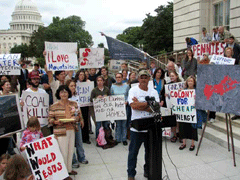
The kids in coal country "deserve a safe, healthy place to go to school," Ed Wiley says on Capitol Hill. He walked all the way from his West Virginia home to raise awareness about Marsh Fork Elementary. (Photo: Vivian Stockman)
[BIG CHEER]
YOUNG: In the months since Wiley’s long walk mountaintop removal mining opponents won an important court victory. The federal court decision could force more thorough environmental review before mines receive federal permits. Congress is considering clean water legislation that would limit the waste rock and dirt dumped into streams.
Wiley raised some money and gained some allies for his campaign, but the school has not moved. The children of Marsh Fork still get their lessons in the shadow of coal.
For Living on Earth, I’m Jeff Young in Marsh Fork, West Virginia.
[MUSIC: Doc Watson & Gaither Carlton “Am I Born To Die?” from ‘Harlan County USA: Songs of the Coal Miner’s Struggle’ (Rounder Records - 2006)]
Links
Database on coal slurry impoundments compiled by safety expert Davitt
Multi-agency federal study of mountaintop removal mining
Appalshop's documentaries on the Buffalo Creek disaster
Ed Wiley's Pennies of Promise campaign
West Virginia coal Association
Video: "Marsh Fork Protests Leads to Capitol Arrests" on YouTube
Living on Earth wants to hear from you!
Living on Earth
62 Calef Highway, Suite 212
Lee, NH 03861
Telephone: 617-287-4121
E-mail: comments@loe.org
Newsletter [Click here]
Donate to Living on Earth!
Living on Earth is an independent media program and relies entirely on contributions from listeners and institutions supporting public service. Please donate now to preserve an independent environmental voice.
NewsletterLiving on Earth offers a weekly delivery of the show's rundown to your mailbox. Sign up for our newsletter today!
 Sailors For The Sea: Be the change you want to sea.
Sailors For The Sea: Be the change you want to sea.
 The Grantham Foundation for the Protection of the Environment: Committed to protecting and improving the health of the global environment.
The Grantham Foundation for the Protection of the Environment: Committed to protecting and improving the health of the global environment.
 Contribute to Living on Earth and receive, as our gift to you, an archival print of one of Mark Seth Lender's extraordinary wildlife photographs. Follow the link to see Mark's current collection of photographs.
Contribute to Living on Earth and receive, as our gift to you, an archival print of one of Mark Seth Lender's extraordinary wildlife photographs. Follow the link to see Mark's current collection of photographs.
 Buy a signed copy of Mark Seth Lender's book Smeagull the Seagull & support Living on Earth
Buy a signed copy of Mark Seth Lender's book Smeagull the Seagull & support Living on Earth

